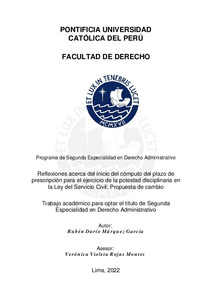Reflexiones acerca del inicio del cómputo del plazo de prescripción para el ejercicio de la potestad disciplinaria en la Ley del Servicio Civil: propuesta de cambio
Abstract
La sanción disciplinaria es un medio que garantiza indirectamente el correcto
desarrollo de la función pública; por lo tanto, la entidad debe instaurar los
procedimientos disciplinarios en un plazo oportuno, a fin de que la potestad
punitiva responda a su finalidad, más aún que constituye una garantía del
servidor el determinar un plazo específico a cuyo término no podrá ser
investigado.
En el régimen disciplinario de la Ley del Servicio Civil, este período temporal –
denominado plazo de prescripción – es de un año a partir de que la oficina de
recursos humanos toma conocimiento de la falta (plazo corto – hechos
conocidos), salvo que no haya tomado conocimiento en el transcurso de tres
años a partir de la comisión de la falta (plazo largo – hechos no conocidos). Por
lo tanto, se entendería que la entidad cuenta con el plazo corto de un año
porque está en la posibilidad de realizar las investigaciones necesarias para
determinar la existencia de responsabilidad disciplinaria.
No obstante, el poder de realizar las acciones de investigación no ha sido
conferido a la oficina de recursos humanos, sino a la Secretaría Técnica; por lo
tanto, surge la paradoja en la que la Entidad – a través de la Secretaría Técnica
– ha conocido de la falta y cuenta con la posibilidad de realizar acciones de
investigación, no obstante, estas acciones de investigación se desarrollarían en
el marco de un plazo de prescripción largo que debería de operar únicamente
cuando la falta aún no haya sido conocida. The disciplinary sanction is a means that indirectly guarantees the correct
development of the public function; therefore, the entity must institute
disciplinary proceedings in a timely manner, so that the punitive power responds
to its purpose, moreover, it is a guarantee for the employee to determine a
specific time period at the end of which he/she may not be investigated.
In the disciplinary regime of the Civil Service Law, this time period - called the
statute of limitations - is one year after the human resources office becomes
aware of the offense (short period - known facts), unless it has not become
aware of it within three years of the commission of the offense (long period -
facts not known). Therefore, it would be understood that the entity has the short
period of one year because it is able to carry out the necessary investigations to
determine the existence of disciplinary liability.
However, the power to carry out the investigation actions has not been
conferred to the human resources office, but to the Technical Secretariat;
therefore, a paradox arises in which the entity - through the Technical
Secretariat - has known about the misconduct and has the possibility to carry
out investigation actions, however, these investigation actions would be
developed within the framework of a long statute of limitations that should only
operate when the misconduct has not yet been known.
Temas
Servicio civil--Legislación--Perú
Sanciones administrativas
Prescripción (Derecho)
Procedimiento administrativo--Perú
Sanciones administrativas
Prescripción (Derecho)
Procedimiento administrativo--Perú
Para optar el título de
Segunda Especialidad en Derecho Administrativo
Collections
The following license files are associated with this item:






